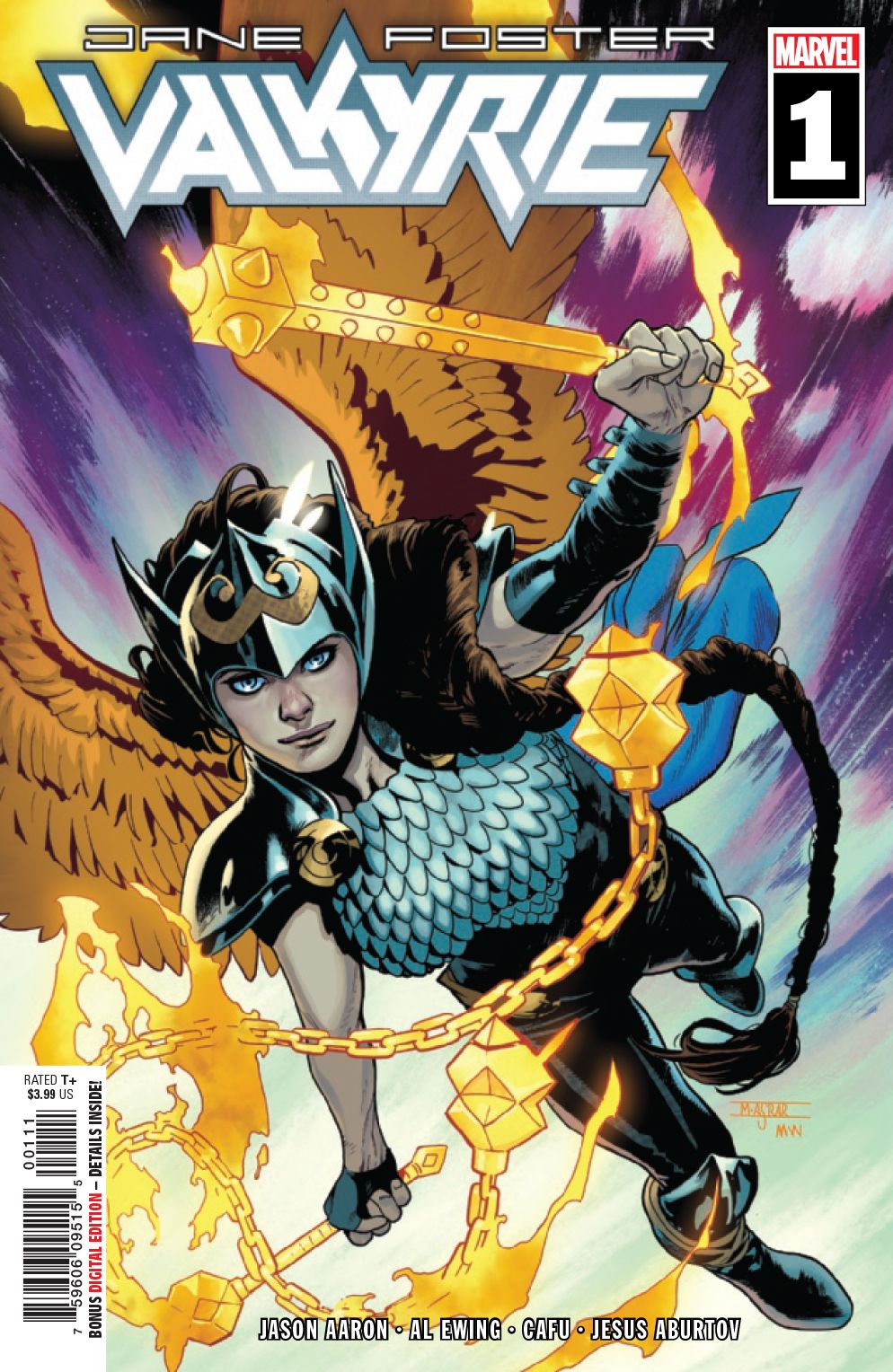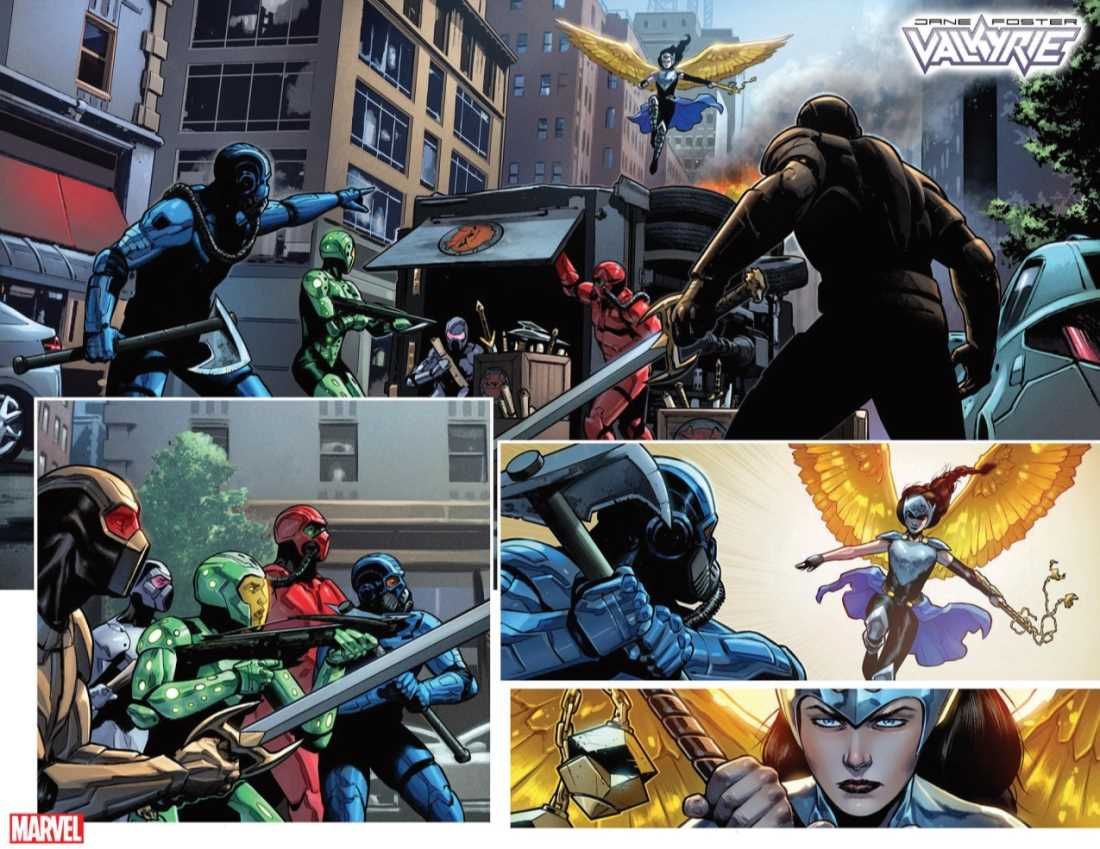REVIEW: Valkyrie: Jane Foster #1
- WRITER
- Jason Aaron, Al Ewing
- Artist
- Cafu
- Letterer
- VC's Joe Sabino
- Cover Artist
- Matthew Wilson, Mahmud Asrar
- Publisher
- Marvel Comics
- Price
- 3.99
- Release Date
- 2019-07-24
- Colorist
- Jesus Aburtov
Life and death are the yin and yang of Jane Foster’s new role in the Marvel Universe. Who better to become the last Valkyrie than Jane Foster? The next chapter in her death-defying life, in Valkyrie: Jane Foster, is the culmination of writer Jason Aaron’s multi-year reimagination of the plucky doctor as a hero. It’s one thing to take up the mantle of a god, it’s another to accept that the sacred duty of a Valkyrie is actually a job — and Jane Foster will learn that facing one’s own death is a far cry from being responsible for the dead.
The War of the Realms left behind Asgardian artifacts and objects of power on Midgard, and naturally, writers Jason Aaron and Al Ewing begin the story with a good fight over them as Valkyrie takes on a low-grade group of bad guys. Jane isn’t impressed with her adversaries, and reveals some of her new abilities, including the amazing Undrjarn the All-Weapon, which not only serves as an adaptable mace but as wings that allow Jane to once again soar through the skies.
With this extended fight scene, Aaron and Ewing tempt you to believe this is just another Jane-as-Thor adventure where she pummels bad guys with a new (and very cool) weapon. But they’ve woven more complex plot threads into this debut issue than you’ll realize on first reading. Unlike many of the Marvel Universe characters these days, Jane Foster is maintaining a secret identity, and that will prove costly. Dr. Jane Foster is also in hot water at work: Her hospital supervisor can’t justify her erratic behavior while she was a cancer patient — after all, why would she skip the chemo treatments that could have helped her? And now Jane’s unreliability even after being cured won’t be tolerated, so she is assigned to the morgue. The irony of her parallel lives is not lost on Jane, as the responsibility for the dead weighs heavily in both. But Jane’s demotion to the morgue will provide the same lesson as her elevation to Valkyrie: The dead have much to teach the living.
In another interesting twist, Jane’s journey to Valhalla reveals she doesn’t exactly know a Valkyrie’s job description. Aaron and Ewing are making her learn as she goes, so she’s relying on her experiences as a god. And while that approach might seem helpful at first, it will cause interesting conflicts later.
CAFU’s fluid art is a perfect complement to the engaging story. Jane cuts an imposing figure as the last Valkyrie, and it’s a delight after so long to see a healthy Jane Foster. The Valkyrie costume has a few welcome nods to Russell Dauterman’s Jane-as-Thor design, making a believable visual transition for Jane’s new job. This issue sets up several conflicts in both parts of Jane’s life, and CAFU’s gorgeous facial expressions convey the emotional weight of her dual responsibilities — Jane doesn’t fully understand what she’s signed up for, and it’s clear that she won’t have an easy learning curve. CAFU writes everything on her face from her confidence in battle, to her shock and hurt at being demoted to the morgue. Pay particular attention to these expressions during Jane’s powerful conversation with Brunnhilde—Jane is focused on a hero’s task of retrieving a stolen sword, and Brunnhilde is concerned throughout that Jane’s priorities are not properly aligned.
Valkyrie: Jane Foster #1 is a worthy successor to Jane Foster’s tenure as the god of thunder. The inventive creative team has set into motion multiple complex conflicts that will test her new abilities and responsibilities both as a Valkyrie and as a doctor. While an enjoyable debut for longtime fans of Aaron’s work with the character, it’s also a great jumping-on point for new readers.


